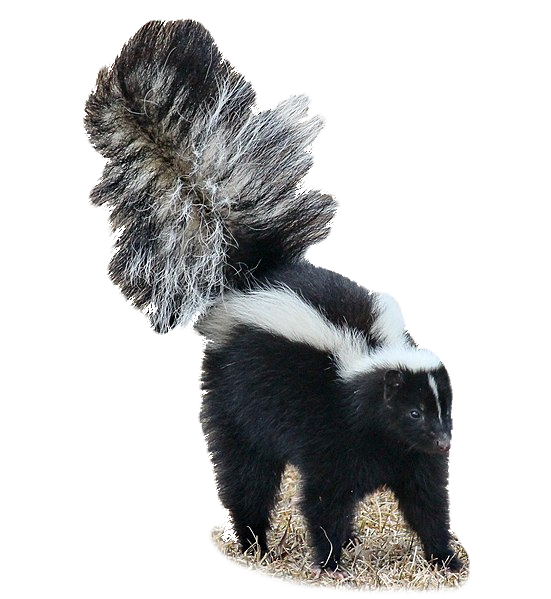
SKUNKS
Scientific Name: Family Mephitidae
Fun Fact: Skunks can legally be kept as pets in 17 US states
Lifespan: In Captivity: up to 10 years. In the wild: between 1 and 7 years
Description
Skunks are North and South American mammals in the family Mephitidae. The animals are known for their ability to spray a liquid with a strong unpleasant smell. Different species of skunk vary in appearance from black-and-white to brown, cream or ginger colored, but all have warning coloration.
Although the most common fur color is black and white, some skunks are brown or grey and a few are cream-colored. All skunks are striped, even from birth. They may have a single thick stripe across back and tail, two thinner stripes, or a series of white spots and broken stripes (in the case of the spotted skunk). Some also have stripes on their legs.
Skunk species vary in size from about 15.6 to 37 in and can weigh between 1 and 18 lbs depending on the species.
Diet
Skunks are omnivorous which means they eat both plant and animal material and changing their diets as the seasons change. They eat insects and larvae, earthworms, grubs, rodents, lizards, salamanders, frogs, snakes, birds, moles and eggs. They also commonly eat berries, roots, leaves, grasses, fungi and nuts.
Skunks also seek garbage left by humans. Less often, skunks may be found acting as scavengers, eating bird and rodent carcasses left by cats or other animals. Pet owners, particularly those of cats, may experience a skunk finding its way into a garage or basement where pet food is kept. Skunks commonly dig holes in lawns in search of grubs and worms.
Reproduction
Male skunks mate in early spring and are active with more than one female. Before giving birth (usually in May), the female digs a den for her litter of four to seven young. After approx. 66 days after mating, the young are born.
When born, skunk kits are blind, deaf, and covered in a soft layer of fur. About three weeks after birth, their eyes open. The kits are weaned about two months after they are born but generally stay with their mother until they are ready to mate at about one year of age. The mother is protective of her kits, spraying at any sign of danger. The male plays no part in raising the young.
How to Get Rid of Skunks
Skunks are rarely a problem for humans. They are nocturnal and do not have a habit of moving in with people. They can however, destroy lawns and flowerbeds looking for grubs and other subterranean insects to eat. The easiest way to get rid of skunks is too control or eliminate the insects they like eat in, and under, your lawn. Once there are no insects to eat, any skunks that may have been hanging around will find some other place to eat.
(706) 221-8000
REQUEST A QUOTE

100% Satisfaction
There is a reason our work is guaranteed…we do it right. If you would ever have a problem with pests while we are in charge of your pest control, we will work until the problem is resolved. Our contracts provide you with quarterly service and we will take care of any problems that may happen to arise between visits.
We Guarantee It!

Request Free Pest Inspection
EMERGENCY SERVICE AVAIALBLE
Request Free Pest Inspection
EMERGENCY SERVICE AVAIALBLE

